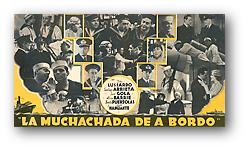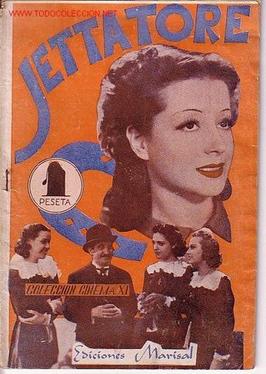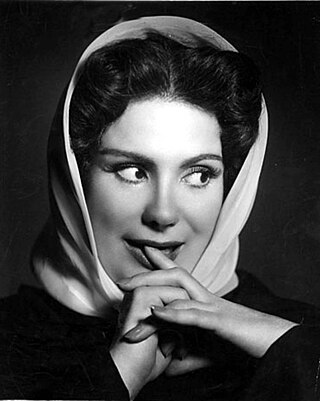![<i>Off to Havana I Go</i> [[Cuba]], [[Argentina]] film](https://upload.wikimedia.org/wikipedia/en/f/f8/Off_to_Havana_I_Go.jpg)
Off to Havana I Go, is a 1950 musical Argentine film directed by Luis Bayón Herrera and written by Carlos A. Petit and Rodolfo Sciammarella. It stars Blanquita Amaro and Otto Sirgo. It premiered on 28 June 1950.

Mecha Ortiz was a classic Argentine actress who appeared in films between 1937 and 1981, during the Golden Age of Argentine Cinema. At the 1944 Argentine Film Critics Association Awards, Ortiz won the Silver Condor Award for Best Actress for her performance in Safo, historia de una pasión (1943), and won it again in 1946 for her performance in El canto del cisne (1945). She was known as the Argentine Greta Garbo and for playing mysterious characters, who suffered by past misfortunes in love, mental disorders, or forbidden love. Safo, historia de una pasión was the first erotic Argentine film, though there was no nudity. She also played in the first film in which a woman struck a man and the first film with a lesbian romance. In 1981, she was awarded the Grand Prize for actresses from the National Endowment for the Arts.

Tito Lusiardo was an iconic Argentine film actor and tango singer of the classic era.

La muchachada de a bordo is a 1936 Argentine comedy film directed and written by Manuel Romero. The film starred Luis Sandrini and Tito Lusiardo. The film was edited by Francisco Múgica.

Jettatore is a 1938 Argentine musical drama film directed by Luis Bayon Herrera. The film premiered in Buenos Aires on August 10, 1938 and starred Tito Lusiardo and Pedro Quartucci. It is a tango musical and is based on a play by Gregorio de Laferrere. The cinematography and editing of the film were performed by Francisco Múgica, who also served as a technical advisor to the films.
Gold in Clay is a 1939 Argentine musical film directed by Luis Bayon Herrera. The tango film premiered in Buenos Aires and stars Tito Lusiardo.
Gente bien is a 1939 Argentine musical film directed by Manuel Romero. The tango film premiered in Buenos Aires on June 28, 1939 and the United States on October 8, 1939 and starred Hugo del Carril, Tito Lusiardo and Delia Garcés.

Elvira Fernández, vendedora de tiendas is a 1942 Argentine comedy film directed by Manuel Romero. It stars Paulina Singerman, Juan Carlos Thorry, Tito Lusiardo and Sofía Bozán. The film is about the daughter of a millionaire store owner, who organizes a worker strike.

A Cuban in Spain is a 1951 musical comedy film directed by Luis Bayón Herrera. It was a co-production between Argentina, Cuba and Spain. The film's sets were designed by Francisco Prósper and Pierre Schild.

The Girl's Houseboy is a 1951 Argentine musical comedy film, directed by Enrique Carreras on his directorial debut with Juan Sires. It is based on a play by Nato Lamarque, which he adapted for the screen. It stars Lolita Torres, Alfredo Barbieri, Tito Climent and Gogó Andreu and was released on 24 October 1951 in Buenos Aires.

Del cuplé al tango is a 1958 Argentine film directed by Julio Saraceni and starring Virginia Luque and Tito Lusiardo.

Marina Esther Traveso, known by her stage name Niní Marshall, was an Argentine humorist, comic actress and screenwriter; nicknamed The Chaplin with a skirt and The Lady of Humour.

Graziosa Maggi, better known as Diana Maggi, was an Italian-born Argentine film, television, radio, and stage actress who was known for starring in the 1950 film Campeón a la fuerza.

Hilda Sour was a Chilean actress and singer, who had an extensive career in Argentina and Mexico.

Women's Prison is a 1951 Mexican drama film directed by Miguel M. Delgado and starring Miroslava, Sara Montiel and Katy Jurado. The film's sets were designed by the art director Gunther Gerszo.

Sabina Olmos (1913–1999) pseudonym of Rosa Herminia Gómez Ramos was an Argentine film actress of the Golden Age of Argentine Cinema (1940–1960).

Honeymoon in Rio is a 1940 Argentine comedy film directed by Manuel Romero and starring Niní Marshall, Tito Lusiardo and Enrique Serrano.

Isabelita is a 1940 Argentine comedy film directed by Manuel Romero and starring Paulina Singerman, Tito Lusiardo and Sofía Bozán.

Three Argentines in Paris is a 1938 Argentine musical comedy film directed by Manuel Romero and starring Florencio Parravicini, Tito Lusiardo and Irma Córdoba. The film's sets were designed by the art director Ricardo J. Conord.

Hortensia Arnaud was a pioneering Argentine dancer, vedette, and actress of film and stage. Arnaud made significant incursions during the heyday of cinematography and revue theater. Above all, she was a pioneer bataclana and premier dancer in Buenos Aires during the 1920s and 1930s.

![<i>Off to Havana I Go</i> [[Cuba]], [[Argentina]] film](https://upload.wikimedia.org/wikipedia/en/f/f8/Off_to_Havana_I_Go.jpg)
















